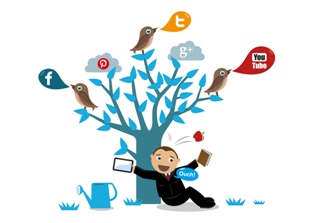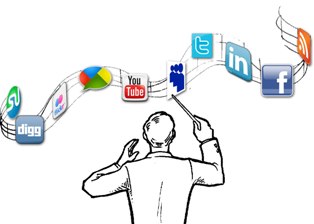The media are diversified media technologies that are proposed to attain a large viewers by mass communication. The technology through which this statement takes place varies. Broadcast media such as radio, recorded music, film and television broadcast their information electronically.

Print media use a corporal entity such as a newspaper, book, pamphlet or comics, to allocate their information. Outdoor media is a appearance of mass media that contains billboards, signs or placards placed inside and outside of commercial buildings, sports stadiums, shops and buses. Other outdoor media comprise flying billboards (signs in tow of airplanes), blimps, and skywriting. Public speaking and event organizing can also be regarded as forms of mass media. The digital media includes both Internet and mobile mass communication. Internet media presents many mass media services, such as email, websites, blogs, and internet based radio and television. Many other mass media outlets have a occurrence on the web, by such things as having TV ads that link to a website, or distributing a QR Code in print or outdoor media to direct a mobile user to a website. In this way, they can make use of the easy accessibility that the Internet has, and the outreach that Internet affords, as information can easily be transmit to many different regions of the world concurrently and cost-efficiently.
Diversification of Media
As the media scenery continues to dimensionalize and distribute a wider range of options, it is becoming more trusted and valued. The media also did a strong work this past year of toping the financial mayhem throughout the European Union as well as numerous corporate crises, including the Bank of America debit card fee, the Netflix/Qwikster snafu, and the India telecoms scandal. Media is also effectually using social networks to help expand the life of its stories and, more important, keep its brands pertinent.
Effect of media diversification on USA, UK and China
In the U.S., trust in all media foundations rose, with major jumps in the perceived trustworthiness of television, radio, and newspapers as sources of information about a company or in educational field as well.
In the U.K., those same sources augmented By contrast, in France and Germany, trust in television news and newspapers fell by ten or more points.
China saw double-digit reduces in television as a trusted source, plunging from 74 to 43 percent. Newspapers in that country didn’t fare healthy either (down by 20 points to 34 percent). But faith in social media jumped: micro-blogging sites and social-networking sites went from practical distrust at just one percent each to being greatly trusted by a quarter (25 percent) and 21 percent, in that order—a likely indication of the rapid growth in social media usage within China. At the end of 2010, Weibo (the Twitter equivalent) had 60 million consumers. By the end of 2011, 310 million users were on Weibo, which broke major news stories, counting the corruption of the Red Cross and a high-speed train crash.
Media and Networking
Networking Media: Network media is fundamentally determined by technological development, rising from the internet as a non-centralized standard in the late nineties, the term has more recently begun to be applied to both the arts and industry.
• Network Media is typically independent and decentralized. The spectators can also be the contributors. Media tells about the right in sequence to the city.
• Network Media frequently requires the participation of computers as an input/output device.
• Network media requires a society to contribute and consume

Social Media
Social media refers to interface among people in which they generate, split, and/or exchange information and ideas in virtual communities and networks. Andreas Kaplan and Michael Heinlein define social media as "a group of Internet-based applications that construct on the ideological and technological basics of Web 2.0, and that allow the formation and exchange of user-generated content."
In addition, social media depend on mobile and web-based technologies to generate highly interactive platforms through which individuals and communities share, co-create, argue, and amend user-generated content. They initiate considerable and pervasive changes to communication between organizations, communities, and individuals.
Broad Classification of social media
• collaborative projects
• blogs and micro blogs
• Social news networking sites
• content communities
• social networking sites
• virtual game-worlds
• virtual social worlds
Tools of Media
 Blogs: Blogs are websites with usual updates and characteristically combine text, images (graphics or video), and links to other webpages. Blogs are frequently informal—taking on the quality of a diary or journal entry
Blogs: Blogs are websites with usual updates and characteristically combine text, images (graphics or video), and links to other webpages. Blogs are frequently informal—taking on the quality of a diary or journal entry
 Mashups : A mashup is a website “that merges data from more than one foundation into a single integrated tool”. Data sources often comprise maps
Mashups : A mashup is a website “that merges data from more than one foundation into a single integrated tool”. Data sources often comprise maps
 Mobile : Mobile is a means of performancing, receiving, and/or sending information to and from cellular phones and extra wireless devices. Mobile includes many things - the mobile web, mobile applications, and text messaging.
Mobile : Mobile is a means of performancing, receiving, and/or sending information to and from cellular phones and extra wireless devices. Mobile includes many things - the mobile web, mobile applications, and text messaging.
 Online Collaborations Tools : The term “wiki” comes out from the Hawaiian word for “fast.” Wiki technology generates a webpage that anyone with admittance to it can modify—quickly and easily, a webpage with an edit button.
Online Collaborations Tools : The term “wiki” comes out from the Hawaiian word for “fast.” Wiki technology generates a webpage that anyone with admittance to it can modify—quickly and easily, a webpage with an edit button.
 Photo Sharing Sites : Photo sharing sites permit you to factually “share photos” online with your friends, family, and colleagues. One of the most ordinary online photo sharing sites is Flickr.
Photo Sharing Sites : Photo sharing sites permit you to factually “share photos” online with your friends, family, and colleagues. One of the most ordinary online photo sharing sites is Flickr.
 Podcasts: Podcasts (a blend of the terms “iPod” and “broadcast”) are audio or video files that you can listen to or watch on your computer or on a diversity of portable media devices.
Podcasts: Podcasts (a blend of the terms “iPod” and “broadcast”) are audio or video files that you can listen to or watch on your computer or on a diversity of portable media devices.
 QR Codes : “QR”(or “quick response”) codes amass information in a two-dimensional square barcode. When checked with a smartphone, QR codes straight users to mobile websites and other functions on their mobile phones.
QR Codes : “QR”(or “quick response”) codes amass information in a two-dimensional square barcode. When checked with a smartphone, QR codes straight users to mobile websites and other functions on their mobile phones.
 RSS Feeds : “RSS” situates for “Real Simple Syndication.” RSS nourish are a way for websites to share out their content to people automatically.
RSS Feeds : “RSS” situates for “Real Simple Syndication.” RSS nourish are a way for websites to share out their content to people automatically.
 Social Bookmarking : Social bookmarking is a way to amass, systematize, and search your favorite webpages on the Internet. In a social bookmarking site, you can keep links to web pages that you desire to remember and/or share.
Social Bookmarking : Social bookmarking is a way to amass, systematize, and search your favorite webpages on the Internet. In a social bookmarking site, you can keep links to web pages that you desire to remember and/or share.
 Social Networking Site : Social network sites are online population that give you opportunities to attach with, or provide possessions to, clients, colleagues, family.
Social Networking Site : Social network sites are online population that give you opportunities to attach with, or provide possessions to, clients, colleagues, family.
 Texting : Text messaging is a method of sending information to and from cell phones and convinced personal digital assistants (PDAs).
Texting : Text messaging is a method of sending information to and from cell phones and convinced personal digital assistants (PDAs).
 Twitter : You can imagine of Twitter as a “micro-blog.” You use your computer or mobile phone to transmit short messages,
Twitter : You can imagine of Twitter as a “micro-blog.” You use your computer or mobile phone to transmit short messages,
 Video Games : Video and computer games are interactive games you play on game plans (such as Nintendo’s Wii, XBox, and Playstation), and computers.
Video Games : Video and computer games are interactive games you play on game plans (such as Nintendo’s Wii, XBox, and Playstation), and computers.
 Video Sharing Sites : Video sharing sites permit you to upload and share online videos similar to photo sharing sites. YouTube is the majority eminent of these types of sites.
Video Sharing Sites : Video sharing sites permit you to upload and share online videos similar to photo sharing sites. YouTube is the majority eminent of these types of sites.
 Webcasts : A webcast is a method of broadcasting over the Internet. A webinar is a explicit type of web conference
Webcasts : A webcast is a method of broadcasting over the Internet. A webinar is a explicit type of web conference
 Widgets : Widgets, Gadgets, describe them what you’d like, but there is absolutely a lot of buzz around these small applications that you can implanted in a social network site, blog, or website.
Widgets : Widgets, Gadgets, describe them what you’d like, but there is absolutely a lot of buzz around these small applications that you can implanted in a social network site, blog, or website.
substances of interest will be situated, identified, monitored, and distantly proscribed through technologies such as radio-frequency recognition, sensor networks, small embedded servers, and energy harvesters - all linked to the next-generation internet using plentiful, low-cost, and high-power computing.